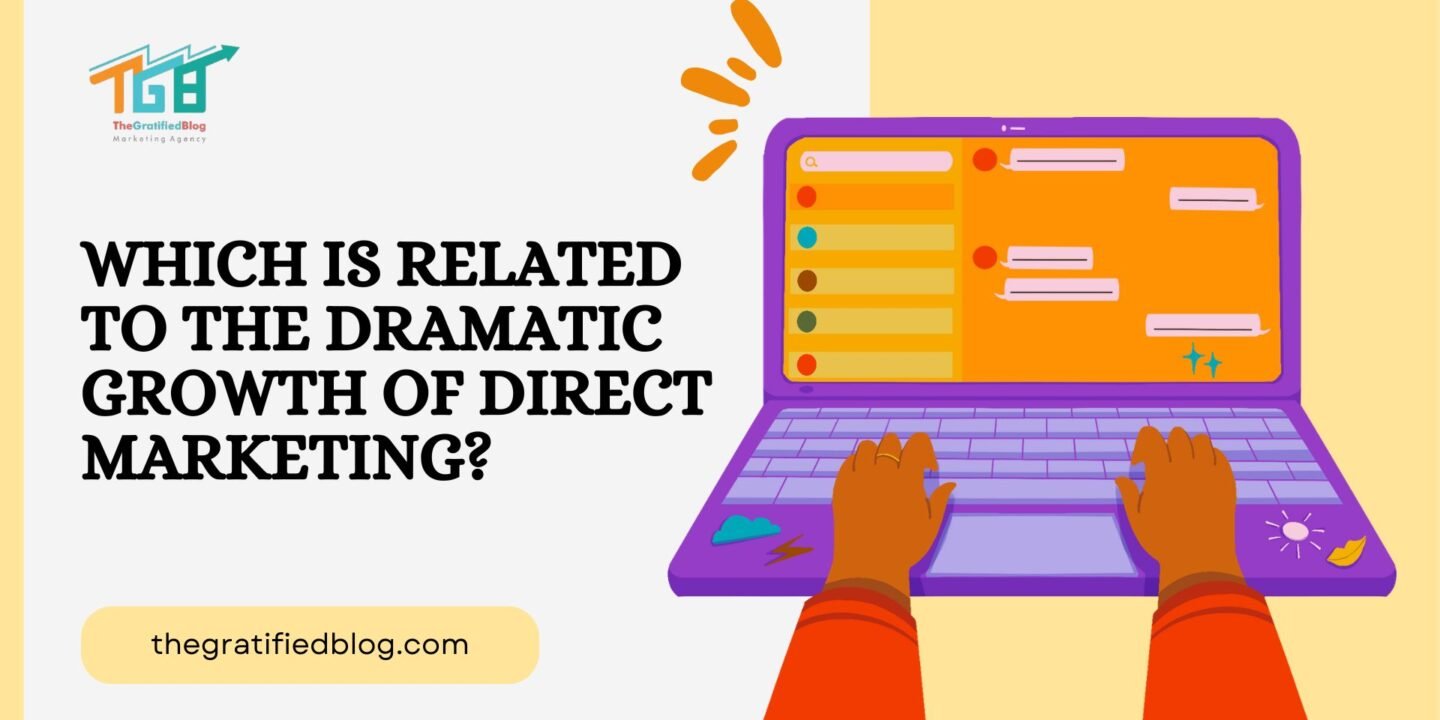
Direct marketing has experienced dramatic growth in recent years, transforming how businesses interact with consumers. With the rise of technology and the widespread use of online platforms, direct marketing has emerged as a robust tool for businesses to directly engage their target audience and elicit immediate responses. This article delves into the pivotal factors driving the significant expansion of direct marketing, “which is related to the dramatic growth of direct marketing?” and its profound influence on the business landscape.
Overview Of Direct Marketing

Direct marketing is a promotional strategy that involves communicating directly with consumers or businesses to promote products or services. This form of marketing aims to establish a personalized and direct connection with potential customers, bypassing intermediaries such as retailers or wholesalers.
Purpose Of Direct Marketing
The primary goal of direct marketing is to generate immediate responses from targeted individuals or organizations. It aims to cultivate customer relationships, drive sales, and build brand loyalty through personalized communication and tailored offers. Direct marketing campaigns often utilize various channels, such as email, direct mail, social media, and telemarketing, to reach and engage with specific audience segments.
Importance Of Direct Marketing In Modern Business
Direct marketing plays a vital role in modern business by enabling targeted communication, delivering measurable results, optimizing marketing budgets, fostering customer relationships, and adapting to changing market dynamics. Its importance continues to grow as businesses seek more efficient and effective ways to reach and engage with their target audience.
Direct Marketing And Integrated Communications In Business
In business, direct marketing is increasingly integrated into broader communication strategies. By aligning direct marketing efforts with other communication channels, such as advertising, public relations, and social media, businesses can create cohesive and impactful campaigns that engage audiences across multiple touchpoints, driving brand awareness and sales.
Channels Of Direct Marketing
Channels of direct marketing encompass a variety of digital and traditional mediums used to directly communicate with target audiences. These include email marketing, social media platforms, direct mail, mobile messaging, telemarketing, and direct response advertising. Each channel offers unique advantages and challenges, allowing businesses to tailor their approach based on audience preferences and campaign objectives.
Digital channels provide real-time tracking and analytics for efficient campaign optimization, while traditional channels offer tangible and tactile experiences that can resonate with certain audiences. By leveraging a mix of channels strategically, businesses can maximize reach, engagement, and conversion rates in their direct marketing efforts.
Key Components Contributing To The Dramatic Growth Of Direct Marketing
Targeting And Segmentation
Direct marketing relies on identifying and segmenting target audiences based on demographic, geographic, psychographic, or behavioural factors. Marketers can tailor their messages and offers to maximize relevance and effectiveness by understanding the unique characteristics and preferences of different customer segments.
Personalization
A hallmark of direct marketing is its emphasis on personalization. Marketers leverage customer data and insights to create customized messages, offers, and experiences that resonate with individual recipients. Personalized communication fosters stronger connections and increases the likelihood of engagement and conversion.
Data-Driven Strategies
Direct marketing campaigns are highly data-driven, relying on analytics and insights to inform decision-making and optimize performance. Marketers track and analyze various metrics, such as response rates, conversion rates, and customer lifetime value, to measure the effectiveness of their campaigns and make data-driven adjustments to improve results over time.
Call-To-Action (CTA)
Direct marketing initiatives typically include a clear and compelling call to action, prompting recipients to take a specific desired action, such as making a purchase, signing up for a newsletter, or requesting more information. The CTA is critical in driving immediate responses and achieving campaign objectives.
Multichannel Approach
In today’s interconnected digital landscape, direct marketing often involves a multichannel approach, leveraging multiple communication channels to reach consumers across various touchpoints. This may include email marketing, social media advertising, direct mail, mobile marketing, and more, allowing marketers to engage with audiences wherever they are and most effectively.
Which Is Related To The Dramatic Growth Of Direct Marketing?
The dramatic growth of direct marketing can be attributed to several factors:
Advancements In Technology
The evolution of technology, particularly the internet and digital platforms, has provided new avenues for direct marketing. Email marketing, social media advertising, and targeted online advertisements have become integral to direct marketing strategies.
Data Analytics
The availability of vast amounts of consumer data allows marketers to segment their target audience more effectively and personalize their marketing messages. Data analytics tools enable marketers to track consumer behaviour, preferences, and purchasing patterns, leading to more targeted and relevant marketing campaigns.
Cost-Effectiveness
Direct marketing can be more cost-effective than traditional marketing channels such as television or print advertising. Digital marketing channels often have lower entry barriers and more precise targeting options, allowing marketers to reach their audience with reduced costs.
Increased Connectivity
The widespread adoption of smartphones and other digital devices has made people more accessible than ever before. Marketers can reach consumers anytime, anywhere, making direct marketing campaigns more effective in engaging with potential customers.
Consumer Preferences
Many consumers prefer personalized and relevant marketing communications. Direct marketing allows brands to tailor their messages based on individual preferences, leading to higher engagement and conversion rates.
Measurement And Accountability
Direct marketing campaigns are often easier to measure in terms of their effectiveness. Marketers can track metrics such as open rates, click-through rates, and conversion rates in real time, allowing them to optimize their campaigns for better results.
Global Reach
Direct marketing campaigns can reach a global audience, breaking geographical barriers. This is particularly advantageous for businesses expanding their reach beyond their local markets.
Overall, the combination of technological advancements, data-driven insights, cost-effectiveness, and consumer preferences has fueled the dramatic growth of direct marketing in recent years.
The Growth And Impact Of Direct Marketing
The growth and impact of direct marketing have been significant in shaping modern business practices. Here’s an overview of its development and implications:
- Explosive Growth: Direct marketing has experienced exponential growth over the past few decades, fueled by technological advancements and changes in consumer behaviour. The widespread adoption of the internet, social media, mobile devices, and data analytics has provided businesses with powerful tools to directly reach and engage with their target audience.
- Targeted Communication: One critical advantage of direct marketing is its ability to deliver personalized and targeted messages to specific audience segments. By leveraging data analytics and customer insights, businesses can tailor their marketing efforts to individual preferences, interests, and behaviours, increasing the relevance and effectiveness of their campaigns.
- Measurable Results: Direct marketing allows businesses to track and measure the performance of their marketing efforts with precision. Metrics such as click-through rates, conversion rates, and return on investment (ROI) provide valuable insights into campaign effectiveness and allow businesses to optimize their strategies for maximum impact.
- Cost-Effectiveness: Compared to traditional forms of advertising, such as television or print, direct marketing can be more cost-effective, especially for small and medium-sized businesses with limited budgets. Digital channels such as email, social media, and search engine marketing offer affordable options for reaching a targeted audience and driving measurable results.
- Enhanced Customer Relationships: Direct marketing allows businesses to engage with customers one-to-one, fostering more profound and meaningful relationships. Businesses can build trust, loyalty, and brand advocacy by delivering personalised messages and offers, leading to long-term customer retention and lifetime value.
- Global Reach: With the rise of e-commerce and digital communication channels, direct marketing has enabled businesses to reach an international audience with minimal barriers. E-commerce platforms, social media networks, and online marketplaces allow businesses to expand their reach beyond geographic boundaries and precisely target niche markets.
- Adaptability and Innovation: Direct marketing constantly evolves to keep pace with changing consumer trends and technological advancements. Businesses are increasingly experimenting with new channels, tactics, and strategies to stay ahead of the competition and engage with consumers innovatively. From influencer marketing to interactive content, direct marketing continues to push the boundaries of creativity and effectiveness.
The growth and impact of direct marketing have been transformative for businesses across industries. Direct marketing has become essential to modern marketing strategies by offering targeted communication, measurable results, cost-effectiveness, enhanced customer relationships, global reach, and adaptability. As technology and consumer expectations evolve, direct marketing will be central to driving business growth and success.
Conclusion
In conclusion, direct marketing’s dramatic growth is a testament to its effectiveness in reaching and engaging with target audiences in today’s digital age. Advancements in technology, data analytics, and consumer behaviour have fueled this growth, enabling businesses to deliver personalized, targeted messages with measurable results. However, with this growth comes ethical considerations such as privacy concerns, permission-based marketing, and environmental impact, which businesses must navigate responsibly. By prioritizing transparency, consumer trust, and compliance with regulations, businesses can harness the power of direct marketing to drive growth while fostering positive relationships with their audience.








No Comments